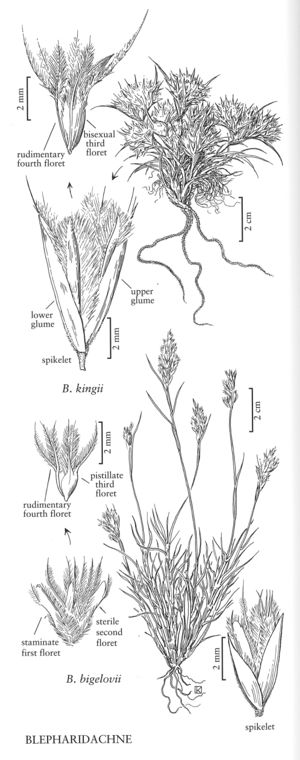Blepharidachne kingii
Plants cespitose. Culms 3-8 (14) cm. Sheaths often with a tuft of hairs at the throat, sheaths immediately below the inflorescences often spathelike; ligules to 0.5 mm; blades 0.7-3 cm long, less than 1 mm wide, strongly convolute to conduplicate, stiffly arcuate, often deciduous. Panicles 10-25 mm, subcapitate, usually partially included in the 2 spathelike upper leaf-sheaths. Spikelets 6-9 mm. Glumes exceeding the florets, papery and translucent, scabridulous toward the base, acuminate or awn-tipped, awns to about 1.3 mm; lower glumes 6-7.5 mm; upper glumes 6.8-8.5 mm; lowest 2 florets usually sterile; lemmas of sterile florets 3.4-5.8 mm, lateral lobes 2.2-3 mm; paleas of sterile florets linear, plumose; third florets bisexual; third lemmas with lateral lobes 0.5-1.5 mm, awned, central awns 3-5 mm; paleas of third florets subequal to slightly longer than the lemmas; anthers 2 (1), about 1.5 mm. Caryopses about 2 mm, compressed. 2n = 14.
Distribution
Utah, Calif., Idaho, Nev.
Discussion
Blepharidachne kingii grows at scattered locations in arid regions of the Great Basin, sometimes being locally abundant.
Selected References
None.
Lower Taxa
"decumbent" is not a number."wider" is not a number.
